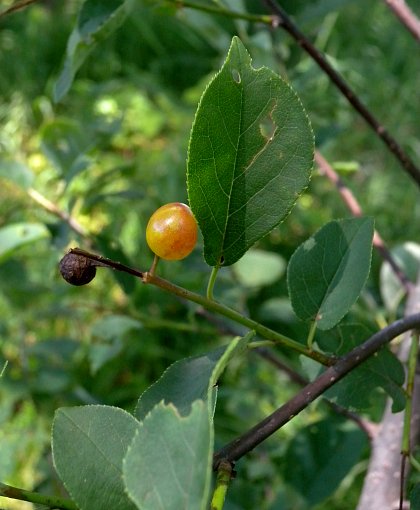
Cylindrical racemes of 10-25 flowers develop at the tips of branches or from short lateral shoots; these racemes are 3½–6" long and about 1" in diameter. Each flower is about ½" across when it is fully open, consisting of 5 spreading white petals, 5 sepals, 15-20 stamens, and a pistil with a single style. The petals are oval to orbicular in shape and clawed (abruptly narrowed) at their bases; the face of each petal is somewhat concave. The sepals are oval in shape, glabrous, partially overlapping, and shorter than the petals. The sepals are initially light green, but they later become yellow; this causes the centers of the flowers to appear yellow. The stamens are about as long as the petals, making them conspicuous. The pedicels of the flowers and the central stalks of racemes are light green and glabrous. The flowers bloom during mid- to late spring, lasting about 1-2 weeks; they have an almond-sweet fragrance. Afterwards, the flowers are replaced by drupes that become mature during the summer. Mature drupes are about 6-10 mm. across, bright red or dark red (in Illinois), and globoid in shape (see Photo). Each drupe contains a a single small stone (seed with a hard coat) that is surrounded by juicy flesh; the flavor of this flesh is bitter and sour. The woody root system is shallow and spreading; sometimes clonal plants are produced from underground runners that can extend several feet. By this means, thickets of clonal plants sometimes form.
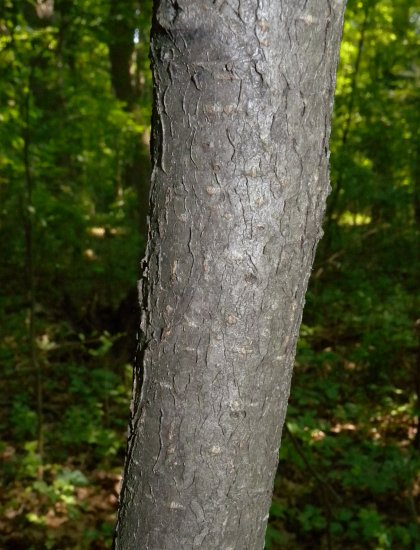
Cultivation: The preference is full sun to light shade and moist to dry-mesic conditions. Many kinds of soil are tolerated, including those that contain sand, silt, loam, glacial till, clay, or rocky material. This woody plant also tolerates soil with varying pH (from acidic to alkaline). Chokecherry develops quickly and it may spread into adjacent areas where it isn't wanted.
Range & Habitat: The native Chokecherry occurs occasionally in the northern half of Illinois, while in the southern half of the state it is rare or absent (see Distribution Map). Habitats include typical woodlands and sandy woodlands, typical savannas and sandy savannas, open disturbed woodlands, woodland openings, woodland borders, wooded ravines, slopes of bluffs, stabilized sand dunes near Lake Michigan, typical thickets and sandy thickets, powerline clearances in wooded areas, fence rows, and abandoned fields. Chokecherry is a pioneer species that colonizes disturbed areas where some of the woody vegetation has been damaged, killed, or removed. While Chokecherry is easily top-killed by fire, it is able to resprout from its root system with little difficulty.
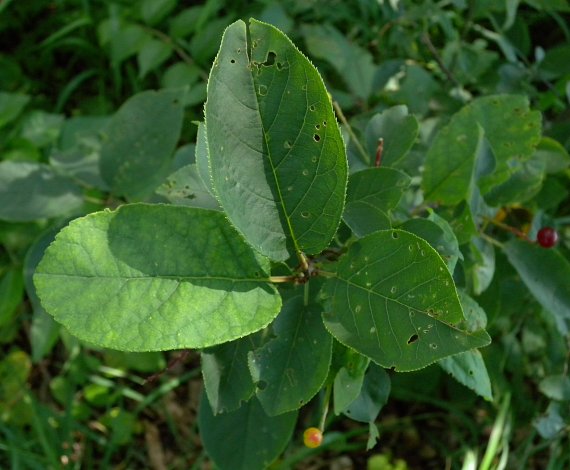
Faunal Associations: The nectar and pollen of the flowers attract cuckoo bees (Nomada spp.), Halictid bees (including greem metallic bees), Andrenid bees (Andrena spp.), Syrphid flies, and various beetles, including long-horned beetles (Cerambycidae), soft-winged flower beetles (Melyridae), and false flower beetles (Scraptiidae). In addition to the flowers, Chokecherry has extra-floral nectaries that attract various ants (Wilhelm & Rericha, 2017; Krombein et al., 1979; Lovell, 1915). The ants are supposed to protect this shrub or small tree from other insects that will eat the leaves. Nonetheless, many species of insects have been observed to feed destructively on Chokecherry. They include the Violet Flea Beetle (Crepidodera violacea), larvae of the Chokecherry Gall Midge (Contarinia virginianae), Chokecherry Aphid (Rhopalosiphum cerasifoliae), leafhoppers, Chokecherry Scale (Aspidiotus cerasi), larvae of the Cherry Shoot Borer Moth (Argyresthia oreasella), larvae of the Ugly Nest Caterpillar (Archips cerasivorana), larvae of other moths, and larvae of the following butterflies: Coral Hairstreak (Satyrium titus), Red-spotted Purple (Limenitis arthemis astyanax), and Tiger Swallowtail (Papilio glaucus). See the Insect Table for more information.
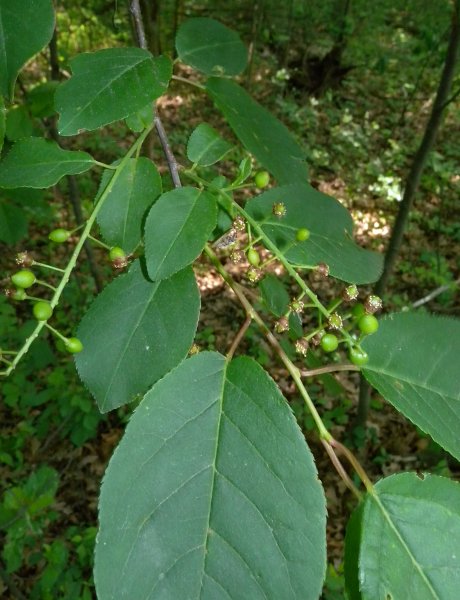
Among vertebrate animals, the fruits of Chokecherry are very popular with various kinds of birds, including the Cedar Waxwing, Northern Cardinal, Scarlet Tanager, Blue Jay, Song Sparrow, White-crowned Sparrow, American Goldfinch, Baltimore Oriole, Gray Catbird, Bobwhite Quail, Ruffed Grouse, Red-headed Woodpecker, Yellow-bellied Sapsucker, European Starling, Veery, Swainson's Thrush, Wood Thrush, Eastern Bluebird, American Robin, Eastern Kingbird, and Warbling Vireo. The Bird Table provides a more complete list of these bird species. Birds that use this small tree or shrub as a nesting site include the Common Grackle and Hooded Warbler (Homan et al., 1996; Bielefeldt & Rosenfeld, 2001).
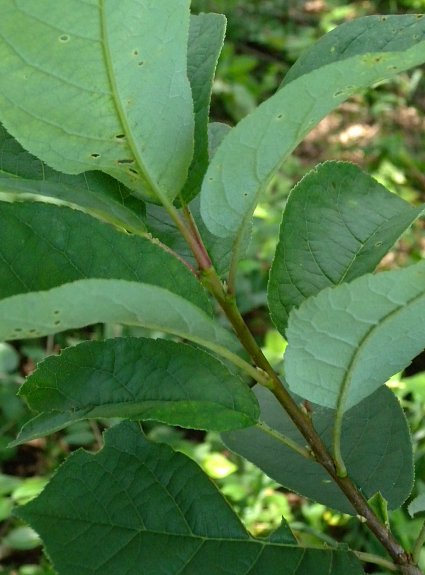
The fruits are also attractive as a food source for several mammals. These species include black bears, foxes, tree squirrels, rabbits, and white-footed mice (Martin et al., 1951/1961; Noyce & Coy, 1990; Peronto & Manley, 2008). Some mammals also gather and spread the cherry pits of this shrub or small tree in order to consume them later in the safety of their dens. These small mammals include the Eastern Chipmunk, Thirteen-lined Ground Squirrel, White-footed Mouse, and Meadow Jumping Mouse (Webb & Willson, 1985). Occasionally, the foliage and twigs of Chokecherry are browsed by moose and deer (Peronto & Manley, 2008); such livestock as cattle and sheep may also consume the foliage and twigs. However, consuming excessive amounts of the foliage in a short time can be poisonous to such animals because leaves that are wilted or damaged release toxic hydrocyanic acid. The foliage becomes less toxic as it becomes older later in the year.
Photographic Location: A woodland at Judge Webber Park in Urbana, Illinois, and a woodland at the Toledo Botanical Garden in Toledo, Ohio.
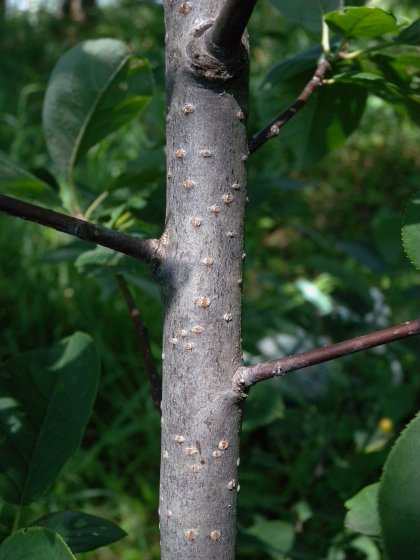
Comments: Chokecherry has a wide distribution across the northern half of the United States and southern Canada. It is similar to another native species, Wild Black Cherry (Prunus serotina), in producing showy racemes of flowers, although the racemes of Chokecherry are slightly shorter in length. While Wild Black Cherry can become a full-sized tree, Chokecherry is a shrub or small tree. These two species can be distinguished by their leaves: the leaves of Wild Black Cherry have a more slender shape and their teeth are incurved, while the leaves of Chokecherry are more broad and their teeth are straight. The native Chokecherry is very similar in appearance to an introduced Eurasian species that is occasionally cultivated, Bird Cherry (Prunus padus). The latter species differs by having shorter stamens on its flowers and it tends to have a more tree-like habit of growth. Like Chokecherry and Wild Black Cherry, Bird Cherry produces its flowers in racemes, rather than in umbel-like clusters. So far, Bird Cherry has rarely naturalized in the wild in Illinois.